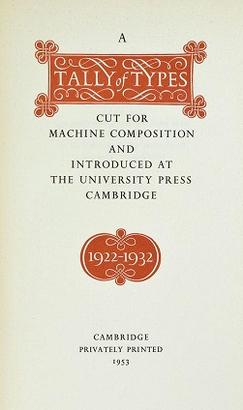 Title page of the first edition | |
| Author | Stanley Morison |
|---|---|
| Subject | Typography |
| Published | 1953 |
| Publication place | England |
| ISBN | 9780521097864 (1973 reprint) |
A Tally of Types [1] is a book on typography authored by the type designer Stanley Morison. [2] It was first published in 1953, and showcases significant typeface designs produced during Morison's tenure at the Lanston Monotype Corporation for their hot-metal typesetting machines during the 1920s and 1930s in England. [3]
Contents
According to Brooke Crutchley, [4] University Printer at the Cambridge University Press, the book "first appeared in 1953, when it was issued as a Christmas keepsake to 'friends of the University Printer in printing and publishing'"; only 450 copies were printed and distributed of this original edition.
The author, a scholarly British pioneer historian and typographer, was the driving force behind Monotype's dynamic typographic programme [5] of research and revival of representative historical typographic models. The book was compiled and written at Crutchley's request.
A Tally of Types, now republished many times, has proven to be an important source of information on typography. In the 1973 edition, three appendices were added, describing typeface designs developed since the original printing. A recent edition includes an introduction by digital-typography pioneer Mike Parker. [6] A Tally of Types holds a critical account, in Morison's erudite style, of the typeface designs cut under his watchful eye during typography's most influential typeface revival project, turning his detailed insight into the inner workings of early 20th century type design into an enduring record of the practice of typography.